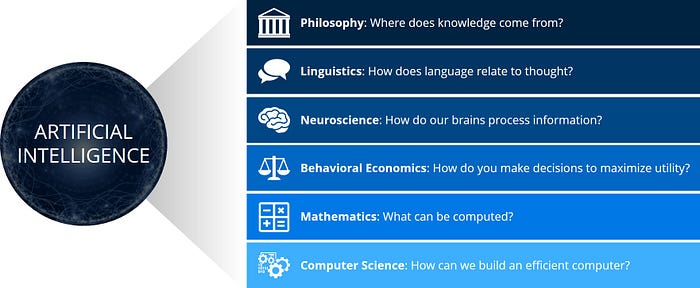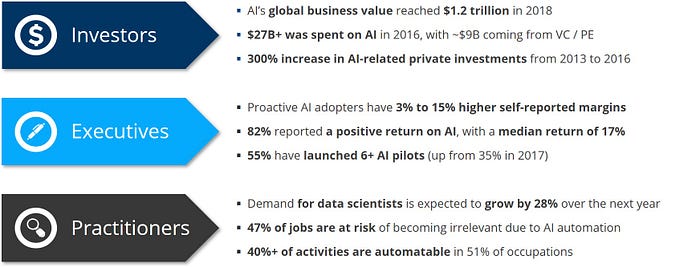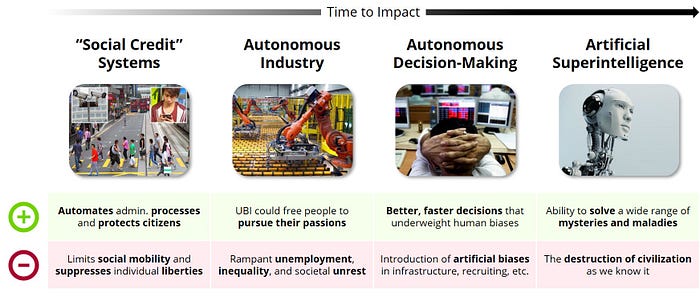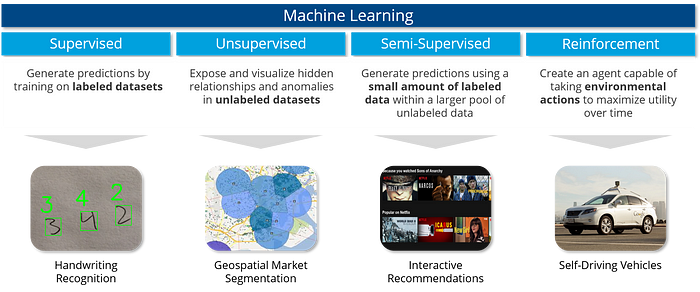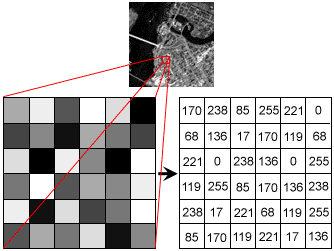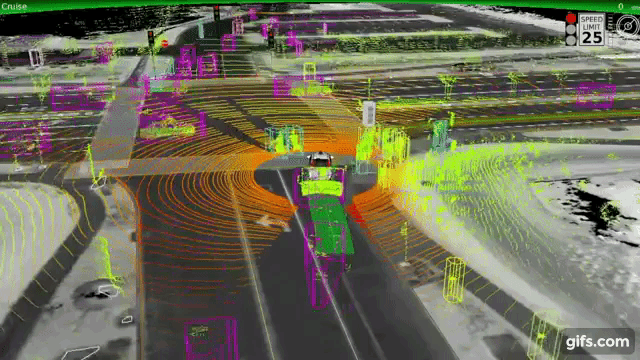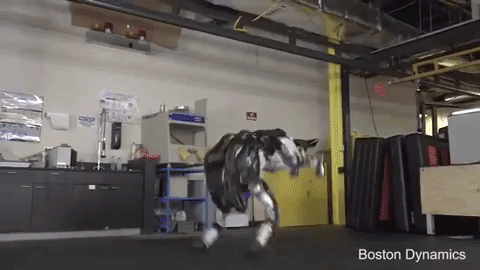Foundations of AI
An intuitive framework for understanding artificial intelligence
Few technologies have captured the human imagination like artificial intelligence. Stories of intelligent robots and artificial beings have pervaded our myths and legends since antiquity, sparking both excitement and fear as our ancestors considered the existence of autonomous machines. These myths continue to influence the narrative surrounding AI and, though we’re closer to developing artificial general intelligence than ever before, it can be difficult to separate fact from fiction given today’s buzzword-laden media.
Though certain use cases have undoubtedly been overhyped, AI has the potential to transform every aspect of how we work, play, and live. In this post, we’ll lay the foundation for understanding this technology by:
- Defining artificial intelligence and describing how it’s impacting our rapidly-changing world
- Simplifying the field of AI into five core research areas
- Bringing each research area to life with anecdotes and examples
Part 1: Definition & Motivations
Artificial Intelligence is the automation of activities we normally attribute to human thinking and rationality, such as problem-solving, decision-making, and learning. AI lives within the intersection of many classic disciplines, including philosophy, neuroscience, behavioral economics, computer science, and mechanical engineering. These interdisciplinary roots help explain why AI has captured our imagination: this burgeoning research field offers a little something for people of all interests and backgrounds. As we evolve our understanding of what AI is and how it works, we simultaneously make headway against the academic community’s most challenging research questions:
AI is certain to impact your career path over the next decade. Though most industries are still in the early stages of proof-of-concept (POC) development, many early adopters are already starting to enjoy the fruits of their labor. In one study, researchers found that F500 companies that proactively adopted AI technology have 3–15% higher self-reported margins than their competitors. These early success signals have triggered a wave of investment, motivating VCs and Corp. Dev. departments alike to spend tens of billions of dollars each year to develop and scale new AI capabilities. This funding has substantially increased the demand for data scientists and ML engineers, giving rise to new educational models (e.g., MOOCs, bootcamps) that support this virtuous cycle by accelerating the pace of AI adoption. No matter what role you play in our economy, you’ve probably already started to notice the effects of this wave:
It’s always wise to approach funding statistics with a healthy dose of skepticism, and it’s unclear whether these same trends will continue in a bear market. Still, the momentum behind these trends suggests that AI will have a long-lasting impact on the business community.
Societal Implications
Outside of the office, AI will also have a far-reaching impact on our society. Though AI has the potential to expedite and improve our daily lives in ways that we haven’t yet discovered, it could just as easily be misused and abused. A few representative examples include:
The concept of “Artificial Superintelligence” (known in research communities as artificial general intelligence, or AGI) is particularly divisive. Though we’re decades away from developing an autonomous agent à la Terminator or Ex Machina, many thought leaders have already started to debate the existential threat posed by superhuman AI. In one corner, Stanford professor and deeplearning.ai CEO’s Andrew Ng is optimistic about the role that AI will play in society:
“AI is the new electricity. Just as 100 years ago electricity transformed industry after industry, AI will now do the same.”
- Andrew Ng
In the other, Tesla and OpenAI CEO Elon Musk argues for a much more conservative approach to AI development:
“If I were to guess what our biggest existential threat is, it’s probably [AI]… With artificial intelligence, we are summoning the demon.”
- Elon Musk
Experts disagree on when we’ll finally achieve AGI, but, as we’ll soon illustrate, we’ve made significant progress towards this goal over the past few years.
Part 2: Understanding AI
In their 1995 classic Artificial Intelligence: A Modern Approach, Berkeley’s Stuart J. Russell and Google’s Peter Norvig broke AI into five distinct research areas originating from the Total Turing test:
- Machine Learning
- Expert Systems
- Computer Vision
- Natural Language Processing
- Robotics
Though the lines between each of these five disciplines has started to blur as we’ve made progress towards AGI, this framework serves as a helpful starting point for understanding AI. In this second section, we’ll offer examples and recent trends across each of these five disciplines.
Machine Learning
Machine learning (ML) is the science of empowering machines to make decisions without human intervention. This sub-discipline forms the backbone of AI, enabling computers to learn and interpret patterns in images, sounds, and structured data using multidimensional arrays. ML is further subdivided into four types of learning:
- Supervised learning: Given an array of features (i.e., week of the year, price, etc.) and a labeled output variable (e.g., sales), predict the best possible estimate of the label variable given some new input array.
- Unsupervised learning: Given an array of features (e.g., demographic information, ZIP code, etc.), expose and visualize hidden relationships and anomalies within the array.
- Semi-supervised: Given an array of features and a limited quantity of some labeled output variable, predict the best possible estimates for the missing label variables.
- Reinforcement learning: Given some objective, train an artificial agent to maximize its utility according to some user-defined utility function.
Supervised learning is the most common form of ML used in the business world today, but that balance may shift as we continue to discover new use cases for the less traditional learning methods. An illustrative example of each learning type is offered below:
Machine learning is to thank for many high-profile innovations over the past few years, but it’s more difficult to do correctly than commonly believed. If statistical best practices aren’t observed, ML models will overfit on previously-observed data points and lead business users astray. We’ll go deeper into this last point during a future discussion.
Expert Systems
An expert system (ES) is an artificial agent which leverages pre-programmed knowledge to offer advice or make decisions. In its simplest form, we can think of an ES as a complicated decision tree or nested if-then logic: if x, y, and w happen, we instruct the computer to do z. Though expert systems don’t enjoy the same hype as machine learning, there are many reasons why we might prefer an ES over ML:
- An expert system can take advantage of human insights discovered through trial and error
- Expert systems are more predictable and are less likely to make extreme errors when faced with previously-unseen inputs
- Expert systems have historically been faster and easier to implement, though ML has become much more accessible in recent years
Expert systems are the most prevalent type of AI and are often incorporated along-side ML to help reduce the downside risk of errant predictions. Google’s Nest home automation technology is a prime example of an ES at work. Users program their preferences into Nest over time, enabling the system to automatically adjust housing temperature to desired levels and reduce heating expenses. Using ML to predict desired temperatures could lead to wild swings in settings and energy costs, so user-defined logic is critical to stabilizing these predictions.
Computer Vision
Computer vision (CV) is the automatic extraction, analysis, and interpretation of images or videos. CV converts photos and videos into numerical arrays, enabling ML algorithms to draw inferences, make predictions, and even generate new images based on user-defined inputs.
Potential uses for CV have been studied for decades, but CV has only recently become possible at scale thanks to three innovations:
- More efficient algorithms: Deep learning (convolutional neural networks, specifically) significantly reduces the memory footprint and computational runtime of CV tasks.
- Better computing resources: GPU improvements, distributed architectures (e.g., Spark), and the availability of inexpensive cloud computing resources have made it cheaper than ever to run memory-hungry CV algorithms.
- Availability of images to train on: The proliferation of social media platforms, community forums, and digital / mobile cameras have drastically increased the number of publicly-available images that can be used to train CV algorithms.
These three innovations have opened the floodgates for new CV use cases, including self-driving cars and automated retailers (e.g., Amazon Go). As cameras, LIDAR, and other spatial sensors become less expensive, we’ll soon find ways to alleviate many of our most inefficient processes using CV.
Natural Language Processing
Natural language processing (NLP) is the automatic extraction, analysis, and generation of human language. NLP algorithms parse sentences in various ways (e.g., splitting by word, splitting by letter, reading both left-to-right and right-to-left, etc.) to automatically draw inferences about the writer’s meaning and intent. NLP’s various use cases include:
- Named entity recognition and conference resolution
- Part-of-speech tagging
- Reading comprehension & question answering
- Machine translation
- Text summarization & topic modeling
- Spellcheck & autocomplete
Like CV, NLP has come a long way over the past decade thanks to innovations in deep learning that have made it faster and easier to train ML models on human language. In the past, engineers would spend hours examining, filtering, and transforming text to avoid computational bottlenecks. Today, out-of-the-box solutions like fast.ai’s NLP library can crush reading comprehension accuracy records without need for time-intensive preprocessing.
Siri and Alexa are great examples of NLP in action: by listening for “wake words”, these tools allow you to play music, search the Web, create to-do lists, and control popular smart-home products — all while your smartphone stays in your pocket. These virtual assistants will continue to improve over time as they gather data from existing users, unlocking new use cases and integrating with the modern enterprise.
Robotics
Robotics is the science of designing, constructing, operating, and applying robots to solve human problems. Robots come in thousands of shapes and sizes, making it difficult to nail down the precise meaning of the term. Joseph Engelberger, a pioneer in industrial robotics, said it best:
“I can’t define a robot, but I know one when I see one.”
- Joseph Engelberger
The field of robotics research has evolved at breakneck speed over the past decade, enabling new designs and use cases that seem to have come straight out of a science fiction novel. Private manufacturers continue to push the envelope of robotics within their respective niches:
- Boston Dynamics, an early innovator in the humanoid robotics space, continues to inch closer to human-simulated movement.
- DJI has focused on consumer-grade drones, making it easier than ever for the average person to take to the skies.
- Amazon Robotics lies at the core of Amazon’s logistics strategy, saving the retail behemoth billions of dollars each year.
Most robots rely on expert systems to accomplish their objective, but the robots of tomorrow will become exponentially more useful by incorporating machine learning, computer vision, and natural language processing into their operating systems.
Conclusion: The Path to AGI
Russell and Norvig’s framework provides a useful structure for thinking about AI, but these five categories aren’t meant to be mutually exclusive; the most exciting innovations of the last decade have occurred within their intersections. This disciplinary blending will only become more pronounced as time goes on: delivery drones, self-driving cars, and artificial general intelligence must tightly integrate all five disciplines if they are to succeed. Still, every complicated problem has to be broken down into its core components before it can be solved, and this five-discipline framework provides a foundational mental model for understanding AI.
As you put this new-found knowledge to use, there are a few guiding principles worth taking back to your team:
- Be skeptical: AI is an umbrella term for five deep, complicated research areas, and it’s exceedingly rare to have technical expertise in all five disciplines. Ask potential candidates about their previous experience and draw your own inferences on where their expertise lies.
- Build a diverse team: Because the most valuable AI use cases lie within the intersection of these disciplines, it’s important to recruit teammates with different backgrounds and skills if your team is to be successful. Recruiting for various job titles (e.g., data scientist, UX designer, ML engineer) is a start, but ask candidates for T-shaped experiences to identify individuals that can wear multiple hats.
- Own your niche: Innovation in one of these five disciplines tends to unlock new ideas in the other four, which means that all five subject areas are in a constant state of flux. Rather than trying to keep tabs on the AI community as a whole, stay up-to-date on the 1–2 disciplines that you feel are most applicable to your business and interests. By doing so, you’ll be able to spot opportunities to apply the latest and greatest technologies to the problems that matter most to you.
